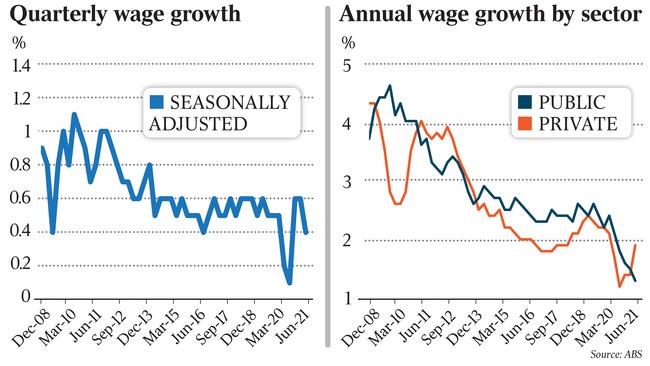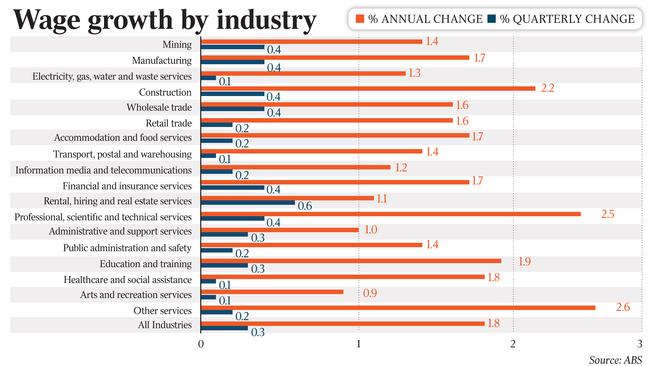‘Disappointing’ wage growth nears historic lows
Australian wages growth slumped to one of the slowest rates in history over the June quarter.

Wage growth has slumped to one of the lowest rates in history, a shock result during a three-month stretch to June of surging employment and reports of labour shortages.
The Australian Bureau of Statistics’ wage price index lifted by 0.4 per cent over the June quarter, markedly slower than the 0.6 per cent pace recorded in the preceding March and December quarters.
The result also pointed to an even weaker than feared wages outcome over the second half of this year, with AMP Capital chief economist Shane Oliver estimating the intensifying Delta lockdowns could drive a severe economic contraction of as much as 3.5 per cent in the September quarter.
Annual wages growth climbed to 1.7 per cent from 1.5 per cent – an increase that reflected the weak comparison point of a year earlier during the depths of the recession.
Economists had expected wages to lift by a further 0.6 per cent in the June quarter, which would have brought the annual increase to 1.8 per cent.
The ABS figures were disappointing in the context of unemployment dropping to a decade-low of 4.9 per cent in June.
Westpac senior economist Justin Smirk said “this much softer than expected outcome suggests that despite reported labour shortages, there has not been a meaningful response by firms to lift wages to attract employees”.
Private sector wages grew by 0.5 per cent in the quarter, bringing the annual pace to 1.9 per cent from 1.4 per cent.

The ABS said the increase in the year-on-year private sector pay figure reflected the “initial dip in wages recorded in June quarter 2020, when the first impacts of the Covid-19 pandemic were recorded”.
Public sector wages growth was steady at 0.4 per cent in the quarter.
Over the year, public servants suffered a real pay cut, after annual wages growth dropped from 1.5 per cent to 1.3 per cent – a new low and under underlying inflation of 1.6 per cent.
Negotiations around new enterprise agreements and the postponement of scheduled wage increases contributed to the weak public sector result, economists said.
Annual wages growth was strongest in Tasmania at 2.2 per cent; pay rises were weakest in South Australia and Western Australia at 1.6 per cent.
By industry, professional services recorded a 2.6 per cent lift in pay over the year as firms competed for talent after cutting pay during the recession.

Construction wages climbed by 2.2 per cent amid a boom in building activity.
At the other end of the spectrum, wages in the arts and recreation sector increased only 0.1 per cent in the quarter, to be 0.9 per cent up over the year, while hospitality pay increased by 0.2 per cent over the three months, despite a surge in job vacancies.
JP Morgan economist Tom Kennedy said margin pressure remained “one of the key headwinds to a sustained wages recovery … Industries where job vacancies are highest, and are big employers, also have the thinnest margins, meaning it’s difficult for these firms to increase wages without jeopardising profitability.”
The disappointing figures also underlined that unemployment could need to fall as far as 4 per cent before wage pressures emerge, justifying the Reserve Bank’s expectation that rates will not need to rise until 2024 at the earliest. The data could also potentially weigh against the RBA’s planned winding back of its bond-buying program from September.
Labour force figures for July, due on Thursday, will provide the first insight into the size of job losses as a result of restrictions, with the bulk of job losses expected to be reflected in the August and September numbers.
Economists predict employment will fall by 46,000, which will push the jobless rate to 5 per cent.







To join the conversation, please log in. Don't have an account? Register
Join the conversation, you are commenting as Logout